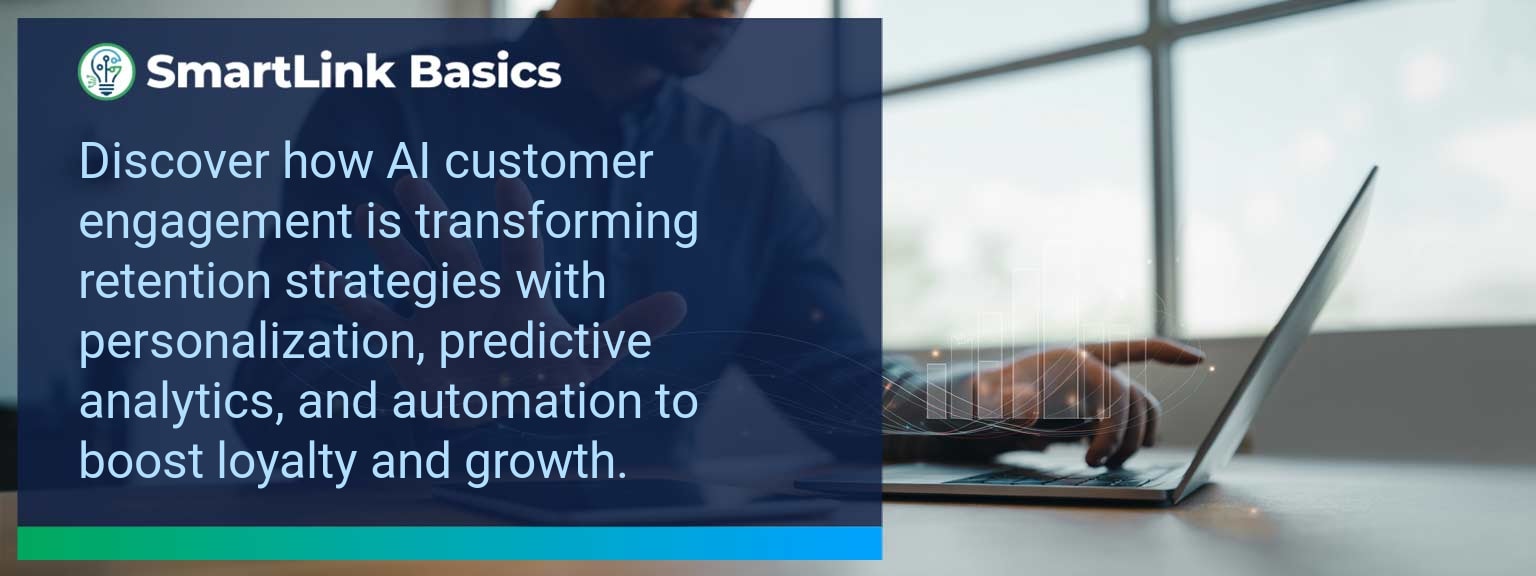Sales leaders face a growing challenge: customer expectations shift faster than traditional engagement strategies can adapt. Companies unable to personalize at scale risk losing client loyalty. SmartLink Basics highlights that adoption of AI tools is no longer optional for B2B organizations seeking growth. By leveraging AI customer engagement capabilities, teams gain real-time insights into client behavior, predict future needs, and automate interactions with unprecedented precision. This article explores how AI is reshaping customer retention strategies, from predictive analytics to automated workflows, and guides leaders on how to operationalize these capabilities effectively.
- AI enables sales leaders to analyze customer behavior in real time.
- Personalization at scale improves engagement and loyalty.
- Predictive analytics identifies churn risks before they escalate.
- Sales automation tools streamline customer interactions and follow-ups.
- Trust and transparency in AI-driven engagement remain critical to retention.
What Changed and Why AI Customer Engagement Matters Now
Traditional engagement strategies relied on generic campaigns and manual follow-ups. Today, AI-driven insights make it possible to personalize outreach based on data, not gut instinct. For B2B sales leaders, the stakes are high: retention is less costly than acquisition, and automation ensures each customer receives timely, relevant interaction.
AI customer engagement technology now supports workflow integration across CRM systems, reducing operational friction. For example, AI-powered platforms can recommend the next best action, turning unstructured customer data into actionable insights. The result is smarter engagement that drives measurable revenue impact.
Redesigning the Revenue Operating System With AI Customer Engagement
ICP, Segmentation, and Targeting
AI in sales helps refine Ideal Customer Profiles (ICP) with predictive analytics. Instead of manual segmentation, AI processes thousands of variables to find high-potential accounts. This level of CRM optimization leads to better targeting and optimized resource allocation.
Pipeline Architecture
Predictive models now indicate which opportunities are likely to move forward, increasing forecast accuracy. Companies leverage revenue operations tools powered by AI to prioritize prospects and streamline pipeline flow. By investing in sales automation, organizations eliminate wasted effort and accelerate conversions.
Plays and Messaging
Personalized messaging once required labor-intensive effort. Now, AI engines analyze engagement history to propose tailored messaging that resonates. For example, account-based marketing campaigns use AI to deliver hyper-personalized content at scale.
Operating Cadence
Effective customer engagement systems depend on consistent execution. By embedding AI into workflow integration, engagement cadence becomes automated, predictive, and aligned with customer preferences. Teams focus more on high-value interactions instead of administrative work.
Applying AI For Personalized Retention
Personalization transforms retention strategies by recognizing individual customer needs. AI tracks behavioral signals such as purchase cycles and interaction frequency, then adapts outreach in real time. For example, AI-driven customer success dashboards flag accounts requiring proactive engagement.
Actionable step: Deploy sales automation that identifies churn risks early and delivers retention plays automatically. This ensures high-value customers receive the right touchpoint before dissatisfaction escalates.
Addressing Barriers To Customer Trust
While AI enhances efficiency, retention depends on maintaining transparency. Clients want to know how their data is used. Sales leaders must ensure compliance and communicate clearly about AI’s role. Strategies that disclose how predictive analytics benefits customers will strengthen relationships.
Leaders can also implement opt-in personalization features within CRM optimization efforts. This reinforces trust while still reaping AI’s benefits.
Measuring Business Impact With AI
The real value of AI in sales emerges when tied to measurable outcomes. Metrics like churn reduction, engagement depth, and pipeline velocity reveal business impact. For example, companies that integrated AI into sales automation reported faster response times and improved upsell conversions.
Actionable step: Define clear retention metrics within revenue operations dashboards. Evaluate both leading and lagging indicators for a balanced view.
| Category | Metric | Definition | Target |
|---|---|---|---|
| Leading | AI Playbook Adoption | % of reps using AI-driven engagement sequences | 85%+ |
| Leading | Personalized Outreach Rate | % of interactions customized using AI insights | 75%+ |
| Lagging | Churn Reduction | Decrease in customer churn rate post-AI integration | 10%+ |
| Lagging | Revenue Expansion | Increase in upsell/cross-sell revenue driven by AI | 15%+ |
| Quality | Customer Feedback Alignment | % of feedback indicating AI-driven personalization was useful | 80%+ |
| Quality | Trust Index | Survey score indicating trust in AI-enabled interactions | 8/10+ |
Get the 90-day plan, coaching rubric, and dashboard template to operationalize AI in your enablement program.
The Leadership Opportunity In AI-Powered Customer Retention
AI customer engagement is redefining how B2B organizations build loyalty through predictive analytics, personalization, and automation. By aligning these tools with revenue operations, sales leaders can create scalable retention strategies that deliver measurable impact. Explore more AI-driven sales enablement resources from SmartLink Basics to accelerate your retention and engagement strategies with confidence.









